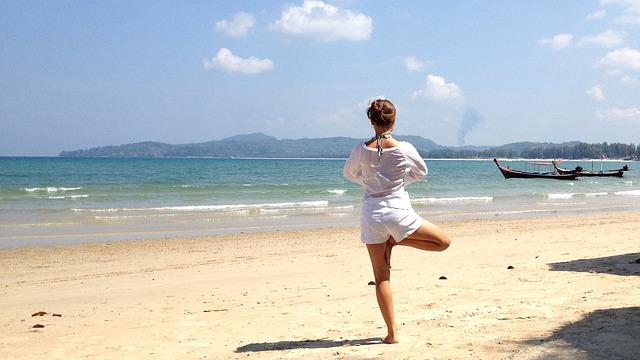Note: This is a response to Another response to an earlier article, Why I Left Yoga (& Why I Think A Helluva Lot Of People Are Being Duped). Read another response here and another here.
16 years ago, panic attacks and anxiety brought me to Yoga and yoga gave me back my breath.
This I mean quite literally; panic attacks and anxiety make it difficult to breathe. Yoga had no bandwagon just yet; it took a thirty minute drive over the Tapan Zee Bridge and a toll to bring me to my Yoga studio.
And you know what I did afterwards? I would go to the bar, smoke and drink and talk about what an awesome class I just had.
How could I do that? Well, I was 25 and had just set foot to path. It was just asana practice at that point and for many years to come. I think it was about ten years before I had my first aha moment.
I had no expectations, so I didn’t get disillusioned. I didn’t look around too much so I didn’t judge how other people did things. I stuck to my own mat, my books, videos, and my teacher whom I really liked. She was older, a retired dancer with a bum knee.
I didn’t move around too much or try too many different teachers and styles—back then Bikram Yoga was the latest fad.
And for the first time as a semi-adult, I didn’t walk away from that relationship when I started seeing things I didn’t like. Because of that, Yoga taught me what I needed to know, what I needed to grow.
What I learned from the practice reached far away from my mat, deep into my life.
I learned what non-harming, or ahimsa to use its Sanskrit and correct name, means.
Most people in general, Yoga practitioners or not, battle with self-abusive behaviours. The mat illustrated this to me via injuries that resulted as a result of pushing too hard. I did that for the same reason I drank too much, ate mindlessly, smoked, burned the candle at both ends, and developed poor relationships: because I was a misguided child (despite of my opinion of myself) behaving without awareness.
We hurt ourselves because we haven’t experienced enough pain yet to finally get to loving ourselves. But the practice teaches us not to judge the level of growth in others. We must all find our own path even when it must travel through fire. This building block of the practice is the same regardless of country. Each culture has its own light and darkness and while some may lean more towards one polar than the other, the truly developed does not sneer at the “lesser”. Light does not hate the darkness.
The Yoga practitioner does not demonize the negative but encourages the positive. By learning how to respect the body on the mat, we can eventually expand that behavior off the mat. But many of us were not taught self-love and we must find it in our own way. Telling people what they should or should not do simply doesn’t work.
2. Yoga is the stilling of the modifications of the mind.
Illusions and opinions are part of these modifications. It is easy to observe a situation and develop an opinion about what is happening behind the scenes. For example, the typical Yoga studio is usually full of white people, most of whom have the disposable income to spend on such things as Yoga classes. One could easily jump to all sorts of conclusions as to why that is, but the fact is that we don’t really know why.
I know Yoga studios that have offered free classes, sliding scale payment options to accommodate different budgets, child care for busy moms, and very reasonable fees such as eight to ten dollars per class. It made no difference. Classes weren’t overflowing with people who would otherwise be unable to take Yoga. Perhaps certain affinities develop due to reasons other than financials. Who knows why Yoga studios in the west studios are so predominantly white; maybe people of other ethnicities prefer other activities.
And perhaps single moms don’t come because they have no time, because affordable classes are definitely out there. Back in the day you would never see a man in a Yoga studio but that has changed. Perhaps these other aspects will change also.
Assuming that all is as the thing which is being observed is a modification of the mind. Just because all Yoga studios I’ve attended are one way does not mean they are all like that. And simply because large groups of people have so far had little attraction to Yoga, does not make those who are there somehow sub-par simply because they don’t belong to those groups.
The teacher is just happy to have someone in front of her. She doesn’t care whether her students are white, financially stable, married, bored, just as she wouldn’t if they were stressed out, single moms on a budget, of some specific ethnicity.
3. Tolerance allows us to understand that we are all learning at our own pace, that it does not matter if you are poor or rich, Indian or American, whether you think apples are better than oranges—and it definitely allows for different tastes in fashion.
Picking apart what people wear is the intolerance of the very young. That means that the $80 pants are just as good as the modest $15 pants, the worn out t-shirts as the tiny Yoga tops. We all have preferences, but ultimately preferring one over the other doesn’t make either one anything more than just an article of clothing.
We wear things because we like the way they look. And yes, in a big connected world, fashion will cross borderlines and sometimes a white woman will wear a sari, a mostly white woman will wear an Asian inspired top, and sometimes an Indian woman will wear western clothing. And it will all be just fine. We allow people to vote however they want to vote, to pray to whatever they wish to pray to, to not
pray, and to wear whatever they want for whatever reason.
4. Acceptance does not mean condoning. It means understanding polarity.
The world includes people who do good and people who do harm, people who respect people and people who make fun of others and take advantage of weakness, ignorance, confusion. We have people whose job it is to remove actual criminals. But even with crimes of the mind, emotion, or spirit, ultimately truth will find its way out. Those who do the crime will eventually do the time.
Those who are victimized will learn that they are taken advantage off, will grow, and not make that mistake again. Deepak Chopra said that no karmic debt goes unpaid. I have no doubt that there is no spirituality behind those who take advantage of others under the guise of bettering the Yoga practice, but does that mean that the person who gave his money to the charlatan did not get anything in return? Using the example of the Indian scam artists taking advantage of the ignorant American “Yogi wanna be” does an unfortunate disservice to the Indian people. It is a little like smearing garbage all over your face just to show people that garbage smells. The practice encourages accepting others as they are even when we think they should be completely different.
5. Any one of the eight limbs of Yoga can be practiced anywhere, anytime.
Breathing, meditating, basic stretching, behaving honorably, can be done whenever, wherever, even at weekend workshops. I don’t know anyone who actually believes that any meaningful change, never mind enlightenment, is something that can be done over the weekend or over a few months of meditation.
But I know many people who come back from retreats who are just a little more aware, more understanding.
Many of us yearn to better ourselves and sometimes a weekend immersion can give us a glimpse of that feeling, that place of understanding, that that thing we seek, that “Yes. That feels right.”
But yes, it’s hard to get there. It requires stillness and patience, both states difficult to get into, and some people need the vigorous asana to slow down enough. The fifteen minutes during lunch, the stolen moments before bed time, the weekend workshop, are all tools. They are opportunities to get just a little closer. Philosophy and asana ARE part of the practice; looking down on those who need it is not.
6. No one is infallible.
In fact, the moment you think that you’re getting it, getting there, you better stop and take a good long look at yourself. Cults, self-absorption, and narcissism happen everywhere, and they stem from the right feeling… like when we strongly believe in some opinion and we wish others would see it our way. Yoga teachers are also students at varying points of learning. Do some get caught up in the grandeur of their own thoughts? Maybe some accept adulation that followers feel the need to give. What yoga teachers do, what followers do, is a symptom of the individual not of the practice.
7. Effective direction on the mat works best when it is expressed in terms of what to do rather than what not to do.
The uneducated practitioner is just that, uneducated. But getting angry at those who don’t know is much like getting angry at someone who can’t just drop into a hands-free headstand on their third class. The teacher may be more skilled, but if she is not also more grown up she will lack the patience to teach the student and will only make the student feel inadequate by looking down on his lack of ability. We are all teachers. Whether it is teaching how to do an advanced posture, how to relax, or how to distinguish between different sects of religions, we must always be careful of feeling superior for knowing things which others don’t.
“Do I need to start wearing turbans and give up my life to practice truly?” I asked Yogi Amrit Desai at a ten day retreat at the Amrit Yoga Institute. I asked that because I also wanted a better practice and had an image of what a true practitioner looks like. His answer was very simple: “Why are you worried about what you don’t want to be? You cannot be who you are not.” There is not only one way to be true to the practice.
Yoga brings the attention to the self.
Yoga means union. Anything that brings focus to the self as a way of discovering the greater truth, is Yoga. Anything that unites body to soul, self to source, self to other, is Yoga. Anything that does not do that, is not Yoga. Criticizing others for being inadequate, for what they wear, for what color or ethnicity they aren’t, for whether they are rich or bored, for being fools, or for not practicing true Yoga, has nothing do with Yoga.
The one thing I definitely learned from Yoga? The moment I start to point fingers at others I need to bring the focus back to me.
So practice this: next time you see something that you want to pick on, bring thy eyes to thine own mat please.
Yoga does not need to grow up—but as practitioners we will always have more work to do.
Love elephant and want to go steady?
Sign up for our (curated) daily and weekly newsletters!
Author: Larisa Klein
Editor: Renée Picard
Photo: Google images free for reuse







Read 0 comments and reply